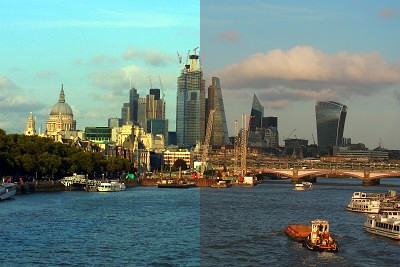Human eyes have a function called colour adaptation that adjusts for differences in colouration, allowing white to be seen as white, red as red and blue as blue. Cameras can not adjust the colour balance to be as we see it. Instead, digital cameras have a function called white balance. White balance is the process of adjusting the colour brightness so that the white colour in a photograph appears right white. Thus, once the white is determined, the overall colour tone changes accordingly. When shooting with a film camera, it is necessary to adjust the colours by changing the film for indoor and outdoor use, whereas digital cameras have such a mode.
The right side of the photo shown is the original as taken, and the left side is the white balance processed by image-editing software “GIMP“. It was taken in London in summer, at 6pm. The afternoon sun is shining on the Thames River from the west. The edited image is cleaner, with dullness removed, but I wonder which is more like the view I saw. I think we can never produce a picture that perfectly matches the scene we see because our brains adjust focus, brightness, etc. So it seems that there is no true white balance and we have to choose according to our preferences, in the end. Even more troublesome, if the sunset is adjusted to give it a warmer glow, the picture will be more beautiful than it actually looks. Anyway, since I have taken the photos, I would not like to change them too much, and not just for white balance.
Click Here to Read the Full Original Article at Looking back now…
